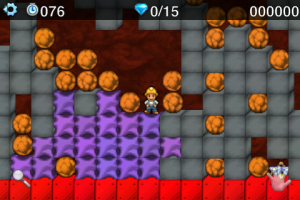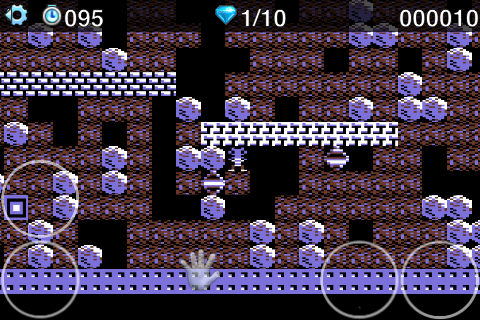 First Star Software’s game of Boulder Dash [App Store] was released into the App Store last night. This year marks the 25th anniversary of this classic game which many of our readers grew up on.
First Star Software’s game of Boulder Dash [App Store] was released into the App Store last night. This year marks the 25th anniversary of this classic game which many of our readers grew up on.
The basic gameplay of Boulder Dash requires the hero to dig through caves to collect gems. Digging simply involves moving your character in any direction. If you dig under an object, however, that object can fall down and crush you. Your goal is to collect enough gems (which can also crush you) while avoiding boulders and other obstacles within the time limit. Meanwhile, there are a number of unique creatures that need to be avoided or used to your advantage. Once you collect enough gems, a doorway will open to the next level. The solutions to every level isn’t immediately obvious and can have a strong puzzle component to them.
The App Store release is called Boulder Dash Vol. 1 and contains the 80 original levels (16 levels across 5 levels of difficulty) from the 1984 release. The game has since seen a number of sequels since 1984, so we’re assuming that the “Vol. 1" designation means additional volumes are on the way to the iPhone. The game includes both updated and original “retro" graphics and sound effects.
The biggest question about any classic game that comes to the iPhone is the one of controls. People who played the original want to relive the original feel of the game, and without a physical joystick on the iPhone, compromises have to be made.

Both original “retro" and updated versions of the graphics and provided.
Boulder Dash for iPhone and iPod Touch is not an exact port of the original game. According to First Star, the speed of the game has been tweaked to provide the most playable experience as possible on this device. The company also notes that the character is now smoothly animated from square to square rather than instantly jumping from one to another as in the original. For long time players this means the speed of the game is slower than you will remember. I actually believe that this is likely a reasonable compromise since it does seem to make the game more playable (note: see major caveat below). Most iPhone/iPod Touch ports of fast-action games have suffered from the poor reaction time of touch-screen controls resulting in frustration.
Boulder Dash offers two touch control and one swipe control option. The touch control pads offer the up/down/left/right buttons in a standard plus-sign configuration (screenshot) or divided (screenshot) into separate up/down or left/right controls. Meanwhile, the swipe controls allow you to swipe anywhere in the direction you want to go. Swiping and holding allows you to continue moving in that direction. Both landscape and portrait orientations are supported.
I found myself most comfortable with the divided touch-screen button configuration in landscape mode as shown in the video, though the swipe control also worked well. With the slower pace of the game, the controls worked well and I was successfully able to dodge boulders, though I do wish I could choose to run at full pace — even at my own peril.
In playing through many of the early levels, I rediscovered that Boulder Dash was, in fact, hard. The solutions to the levels are not immediately obvious and I started running into trouble within the first 8 levels. But that’s what made the game so satisfying back in the day — you would spent some real time figuring out how to win a level.
There are some performance issues in the game, however, that will make it a deal-breaker for specific audiences. The game performed significantly slower on an iPhone 3G I tested than it did on an iPod Touch (2nd Generation). This experience is being echoed by iPhone owners in our forums with some calling the game unplayable in its current form. This appears to be a 1.0 oversight that will be addressed in a future update, but, for now, those who don’t own a 2nd Generation iPod Touch should probably avoid this release. Meanwhile, the gameplay on the 2nd Generation iPod Touch in the default zoom-mode was perfectly acceptable, although zooming out to a large degree also resulted in slow-downs (see video).
The embedded video shows a couple of things. First it shows Level 1 on an iPod Touch 2nd Generation and then the same level on an iPhone 3G. The iPhone 3G performance is much slower. The same level was run in 57 seconds on the iPod Touch while it took 1 minute 21 seconds on the iPhone 3G. Finally, the video shows a later level with updated graphics taken on the iPod Touch 2nd Gen. Zoom in / out is shown as well as gameplay at the normal zoom level. Due to the nature of YouTube, some performance differences may be hard to discern.
|
||||||||||||||||||||